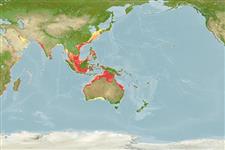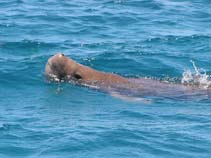Dugong dugon (Müller, 1776)
Dugong| Native range | All suitable habitat | Point map | Year 2050 |

|
| This map was computer-generated and has not yet been reviewed. |
| Dugong dugon AquaMaps Data sources: GBIF OBIS |
Classification / Names Common names | Synonyms | CoL | ITIS | WoRMS
Mammalia | Sirenia | Dugongidae
Environment: milieu / climate zone / depth range / distribution range Ecology
Benthopelagic; depth range 0 - 200 m (Ref. 81173), usually 1 - 40 m. Tropical; 30°N - 37°S, 32°E - 178°W
Distribution Countries | FAO areas | Ecosystems | Occurrences | Introductions
Indo-Pacific: Dugong dugon hemprichii: Red Sea, Aqaba, Suez Canal; Dugong dugon dugon: Gulf of Aden, Mozambique, Persian Gulf, Pakistan, India, Myanmar, Malay Peninsula, Gulf of Thailand, Vietnam, Gulf of Tonkin, Comoros, Madagascar, Mauritius, Rodriguez, Sri Lanka, Andaman Islands, Indonesia, Ryukyu, Taiwan, Philippines, Guam, Palau, Micronesia, Caroline Is, Papua New Guinea, Solomon, New Caledonia, Australia, Fiji (Ref. 1522).
Length at first maturity / Size / Weight / Age
Maturity: Lm ? range ? - ? cm Max length : 406 cm TL male/unsexed; (Ref. 91927); max. published weight: 400.0 kg (Ref. 1394); max. reported age: 20 years (Ref. 91927)
Life cycle and mating behavior Maturity | Reproduction | Spawning | Eggs | Fecundity | Larvae
Main reference
References | Coordinator | Collaborators
Tan, J.M.L. 1995 A Field Guide to the Whales and Dolphins in the Philippines. Makati City: Bookmark. 125 p. (Ref. 936)
IUCN Red List Status
(Ref. 130435: Version 2025-1)
CITES status (Ref. 108899)
CMS (Ref. 116361)
Threat to humans
Human uses
Fisheries: of no interest
FAO - Fisheries: species profile | FishSource | Sea Around Us
Tools
More information
Max. ages / sizes
Length-weight rel.
Length-length rel.
Length-frequencies
Mass conversion
Abundance
Internet sources
BHL | BOLD Systems | CISTI | DiscoverLife | FAO(Fisheries: species profile; publication : search) | Fishipedia | GenBank (genome, nucleotide) | GloBI | Gomexsi | Google Books | Google Scholar | Google | PubMed | Tree of Life | Wikipedia (Go, Search) | Zoological Record



